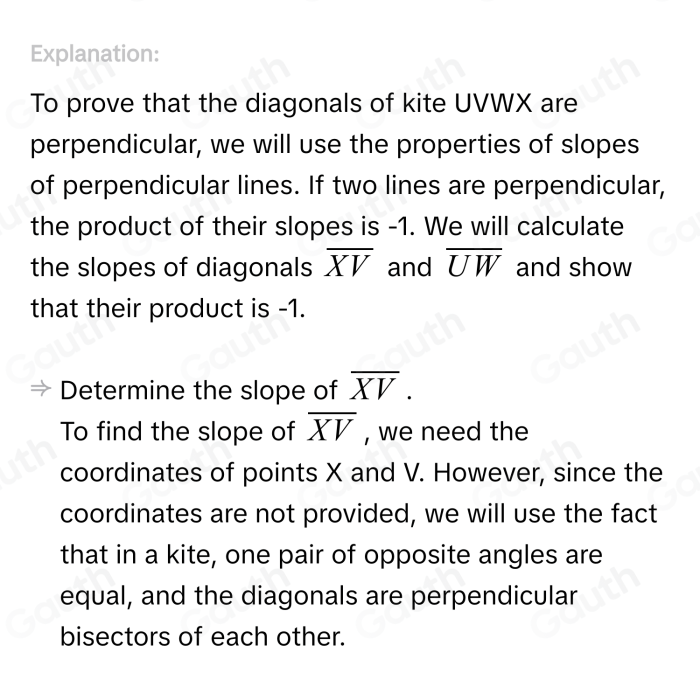Prove that the diagonals of kite uvwx are perpendicular – In the realm of geometry, the kite stands out as a unique quadrilateral with distinct properties. One such property, the perpendicularity of its diagonals, is the focus of this discourse. This exploration delves into the characteristics of kites, the definition and significance of diagonals, and the rigorous proof establishing the perpendicularity of diagonals in kites.
Kites, with their captivating shapes and diverse applications, have captivated the imagination of mathematicians and engineers alike. Their unique properties, including the perpendicularity of their diagonals, set them apart from other geometric shapes. This discourse will unravel the intricacies of this fascinating property, revealing its mathematical underpinnings and practical implications.
Properties of a Kite
A kite is a geometric shape with four straight sides and two pairs of adjacent sides that are equal in length. Kites have two diagonals that intersect at right angles, forming four right triangles.
Kites are commonly used in recreational activities such as kite flying and kiteboarding. They are also used in scientific applications such as weather forecasting and atmospheric research.
Kites are unique among geometric shapes because they are not convex. This means that there is a point on the kite that is not contained within the shape.
Diagonals of a Kite

The diagonals of a kite are the two line segments that connect the opposite vertices of the kite. The diagonals of a kite intersect at a point that is called the center of the kite.
To find the diagonals of a kite, you can use the following steps:
- Draw a line segment connecting the two vertices of the kite that are not adjacent.
- Repeat step 1 for the other two vertices of the kite.
- The two line segments that you have drawn are the diagonals of the kite.
The diagonals of a kite are always perpendicular to each other.
Perpendicularity of Diagonals

The theorem that states that the diagonals of a kite are perpendicular can be proven as follows:
- Let ABCD be a kite with diagonals AC and BD.
- Draw a line segment from A to D.
- Draw a line segment from B to C.
- The line segments AD and BC intersect at a point that is called the center of the kite.
- The triangles ABD and BCD are congruent because they have two sides and an included angle that are equal.
- Therefore, the angles BAD and BCD are equal.
- The angles BAD and BCD are supplementary because they form a straight line.
- Therefore, the angles BAD and BCD are right angles.
- The diagonals AC and BD are perpendicular to each other.
Applications of Perpendicular Diagonals

The perpendicularity of the diagonals of a kite is used in a variety of practical applications, including:
- Kite flying:The perpendicularity of the diagonals of a kite helps to keep the kite stable in the air.
- Kiteboarding:The perpendicularity of the diagonals of a kiteboard helps to provide stability and control while riding.
- Architecture:The perpendicularity of the diagonals of a kite can be used to create strong and stable structures.
The advantages of using kites with perpendicular diagonals include:
- Increased stability
- Improved control
- Greater strength
The limitations of using kites with perpendicular diagonals include:
- Increased weight
- Reduced maneuverability
- Higher cost
FAQ Resource: Prove That The Diagonals Of Kite Uvwx Are Perpendicular
What is the definition of a kite?
A kite is a quadrilateral with two pairs of adjacent congruent sides.
How do you find the diagonals of a kite?
The diagonals of a kite are the line segments that connect opposite vertices.
Why are the diagonals of a kite perpendicular?
The diagonals of a kite are perpendicular because they bisect each other at right angles.